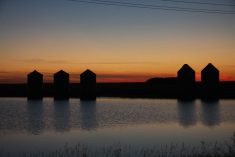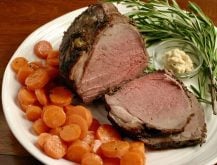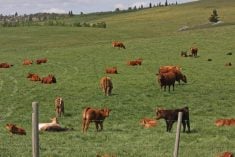When this article comes to print, Easter will be rapidly upon us. This
reminds me of the traditional Easter Bunny Cake we used to have such
fun making when our kids were small.
Using two round 8 x 9 inch (20 x 22 centimetre) layer cakes, we would
carve a semi-circle for a bunny ear out of each side of one of the
round layers, thus leaving a “bow-tie” in the middle of that layer. The
other cake would be the bunny face. An ear was placed on each side of
Read Also

Know what costs are involved in keeping crops in the bin
When you’re looking at full bins and rising calf prices, the human reflex is to hold on and hope for more. That’s not a plan. It’s a bet. Storage has a price tag.
the top of the face, and the bow-tie at the bottom of the face. Candy,
fruit or nuts were used for eyes, nose and mouth and licorice for
whiskers. The kids would choose the colour of icing for the bunny –
green, pink, purple or blue.
Here’s another idea I found. This cake is more vertical with the
bunny’s back up in the air.
- You will need only one layer cake. When cooled, cut the round in
half, frost the top of one half, and place the other on top of it.
- Arrange the cake upright on a platter with the cut sides down. Cut
out a small triangle about 1/3 of the way down for the neck and round
the edges with a knife to form where the head joins the body.
- Frost the cake with white frosting and sprinkle it with a layer of
coconut fur. For a pink bunny, you can mix the coconut with four drops
of red food colouring.
- Decorate with construction paper ears, and use jelly beans or
gumdrops for eyes, nose and mouth. Black shoestring licorice makes
good whiskers, and a marshmallow makes the perfect cotton tail.
What about wild stuff?
Dear TEAM: While reading your Feb. 14 article on rice, I noticed you
had nothing on wild rice. Wild rice is growing in popularity so I
thought your readers might be interested in the information I have
enclosed with this letter. – L.P. Denare Beach, Sask.
Dear L.P.: TEAM always looks forward to receiving letters from our
readers. C.P., Waseca, Sask., also gently reminded us not to forget
about wild rice. She enjoys wild rice as a first course, in a dessert
and also popped.
Wild rice grows in the shallow, sheltered lakes and streams of northern
Saskatchewan and Manitoba. It matures slowly through the summer months,
free of pesticides and herbicides, helped only by the sun. This natural
ripening takes longer, but yields a grain unequalled by any other –
longer, plumper, with a rich taste and high nutrient content.
Wild rice expands four times in volume when cooked. To cook, put wild
rice in wire strainer and rinse with cold water.
Bring to boil using four cups (one litre) of water to one cup (250 mL)
wild rice. Cover and reduce heat to a gentle boil for 50-60 minutes
until kernels puff open to reveal a white interior. Remove from heat
and drain. For a chewier texture, reduce cooking time. For fluffier
rice, let stand 30 minutes before draining. Raw wild rice will keep
indefinitely when stored in a clean, dry place.
Suggestions:
- If you want to reduce cooking time, soak overnight.
- Once cooked, wild rice can be frozen in airtight containers for
convenience or kept in the refrigerator for up to two weeks.
- Heat cooked wild rice with cream, brown sugar and cinnamon for a
delicious, nutritious breakfast.
- Add cooked wild rice to hash browns or fried potato dishes.
- Add cooked wild rice to a pancake or waffle recipe, using 1/2 cup
(125 mL) for every six pancakes your recipe makes.
- Stir cooked wild rice into jellied salads or sprinkle cold onto green
salads.
- As an addition to soup use 1/2 cup (125 mL) of cooked wild rice for
every four servings.
- For a difference, substitute cooked wild rice in all meat, poultry,
fish and vegetable stuffing.
Why not incorporate wild rice into Easter meals this year?
Try the following fruit salad or dessert. This has been a family
favourite for years, but the addition of the wild rice pumps up the
nutrition with a unique nutty flavour.
Wild rice creamy fruit dessert
1 can (14 oz.) sliced 398 mL
pineapples, drained
1 can (10 oz.) 294 mL
mandarin oranges, drained
1 can (14 oz.) fruit 398 mL
cocktail, drained
1/2 cup chopped 125 mL
walnuts
3 cups miniature 750 mL
marshmallows
1 cup whipped topping 250 mL
4 cups cooked wild rice 1 L
maraschino cherries
Mix all ingredients and refrigerate. Source: Saskatchewan Wild Rice
Council Inc.
Honey nut wild rice bread
1/4 cup softened butter 50 mL
1/4 cup honey 50 mL
2 eggs
11/3 cups cooked wild 325 mL
rice
1/2 cup chopped pecans 125 mL
11/4 cups whole wheat 300 mL
flour
1 teaspoon baking 5 mL
powder
1 teaspoon salt 5 mL
1/4 teaspoon ground 1 mL
cloves
1/4 teaspoon ground mace 1 mL
3/4 cup milk 175 mL
Heat oven to 325 F (160 C). Cream butter and honey in large mixing
bowl. Beat in eggs, one at a time, until smooth. Stir in cooked wild
rice and nuts.
Mix flour, baking powder, salt, cloves and mace in a small bowl. Add to
ingredients in large bowl alternately with milk until smooth. Pour into
well-greased loaf pan.
Bake until toothpick can be withdrawn clean, about 55Ð60 minutes.
Remove from pan and cool.
Barbara Sanderson is a home economist from Rosetown, Sask., and one of
four columnists comprising Team Resources. Send correspondence in care
of this newspaper, Box 2500, Saskatoon, Sask., S7K 2C4.














